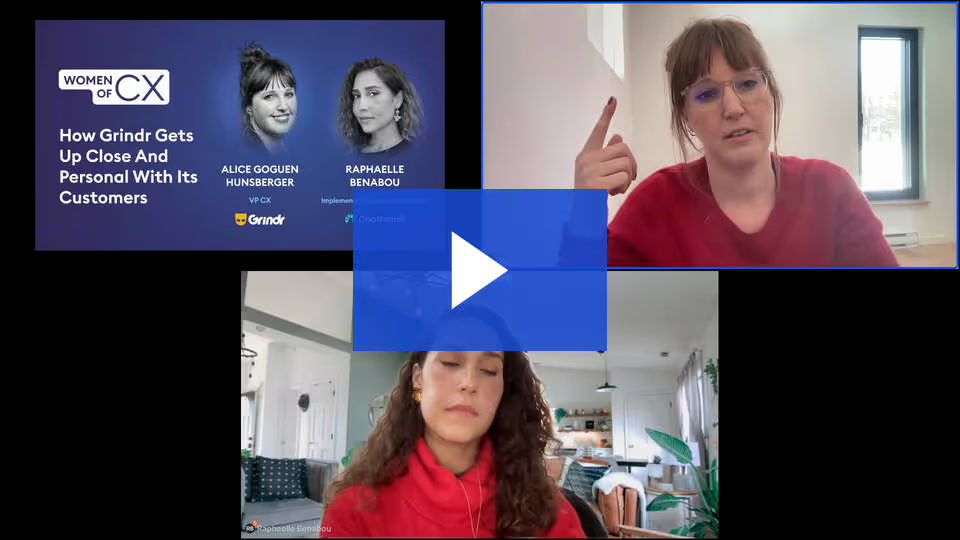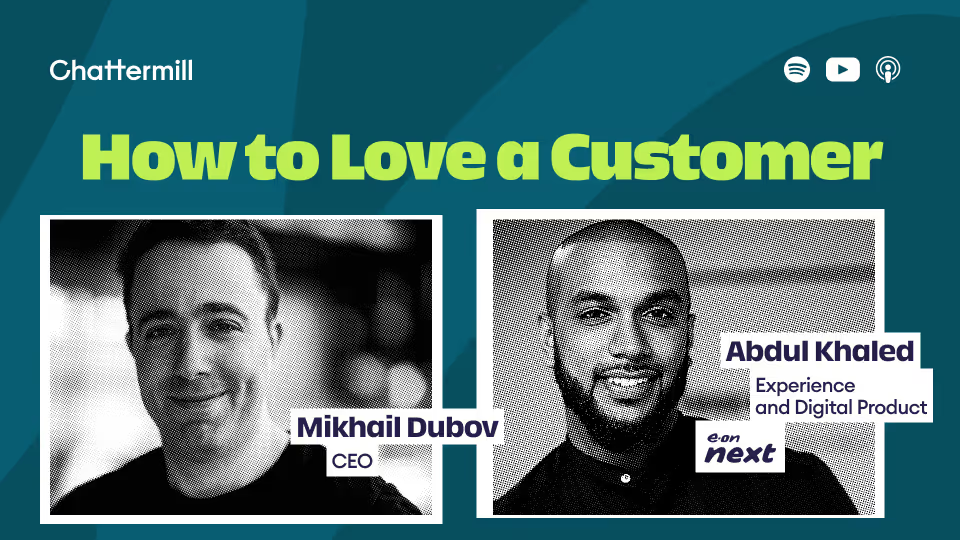How does Grindr get up close and personal with its customers?
To find out, we’re joined by Alice Hunsberger, the Global Head of Customer Experience at Grindr.
Hunsberger is an expert in dealing with online dating apps, particularly in the area of safety, with a background in CX spanning over a decade at OkCupid prior to Grindr. For the past five years, she has continued to excel at Grindr, focusing on what she knows with an additional focus on the LGBTQ+ dating space.
To name just a few of her accomplishments at Grindr, Alice took CX from a liability to an asset during the ramp-up to going public and founded a Voice of the Customer program from scratch.
“I help global social media platforms feel human, inclusive, and authentic.”
We’re excited to present to you the key takeaways from our live Women of CX Webinar, where Alice speaks to Raphaelle, our Implementation Function Lead at Chattermill. The full episode – including the Q&A – is, as always, available to watch below.

Women of CX: Alice Goguen Hunsberger, VP CX, Grindr - Chattermill
What has your journey been like into the world of CX?
“It was entirely on accident, and at the same time, not an accident at all!”.
Hunsberger started out in CX almost 20 years ago, with a self-produced online forum for music and vinyl record trading. This was the start of Hunsburger’s experience in building a community and resulted in her single-handedly moderating a community of about 1000 people.
While this was a hobby, Hunsburger continued to be drawn to building and maintaining communities.
She first worked as a documentary film editor for a few years, following her degree in film, but her community-building skills led to her becoming the first CX hire at OkCupid, building the function from the ground up and being the very first moderator.
“I got sucked in from there”
What has your experience been as a woman in CX?
When Hunsberger joined OkCupid, the company was very small – only 20-30 people. Even so, Hunsberger was one of the only women on the team.
“It was pretty lonely, and I hadn’t had a woman as a boss until just this year at Grindr!”
Up until then, Hunberger said that she had always reported to men. The landscape of diversity in the tech industry has changed a lot over her career. At Grindr, they make it a point to hire inclusively and include women in the C-suite.
“I'm definitely learning from [my current boss] about how to be a strong, confident female leader. And, you know, I've been coming into that confidence myself. Over the last few years, I feel a lot more able to do things, like this webinar, and talk to people and be out there and state:
I actually do know what I'm talking about, and I've been doing this for a long time. I am a bit of an expert.”
How have perceptions changed around CX?
Expectations around CX have definitely changed, particularly around content moderation.
Back when Hunsberger started 20 years ago – much before Meta, Instagram, and any other major platform was popularised – the internet was still a place for free expression and free speech. People didn’t really have an expectation that a platform should intervene in a user interaction.
20 years later, the negative repercussions of that non-moderation are evident. Community spaces should be safe, and people want more control over their experiences. People want to curate what they see.
Now, we see a more thoughtful balance between privacy, safety, and positive community experiences.
Have you found it difficult to prove the importance of CX to senior leadership?
Customer experience and product development go hand in hand.
If leaders in the C-suite believe in the importance of the customer's voice, that’s great. To prove its value, though, it’s important to zoom out and focus on the experience that you’re trying to deliver.
For example, take social media like LinkedIn, TikTok and everything in between. People are on there to interact with each other to see content generated by each other. The platform is, in essence, creating the platform.
Product teams decide how those interactions are shaped, how it's curated, what’s allowed and not allowed, how people interact with each other, what the rules and standards are, and what the content looks like. All of those shape the experience of the user.
So, it’s easy to just reduce it to: “Hey, look, the importance of the platform is the buttons people click and the hardware that makes that work in the back end”.
It’s easy to forget that half of it is the users themselves. An equal amount of attention must be paid to curating those experiences, as you do to build the buttons themselves. Otherwise, the product just won’t be good.
“That's the argument that I tend to make with customer experience.” Hunsberger continues.
It's not just content moderation. It's any interaction that you have with a customer. So if you are with a company that doesn't have user-generated content, your help centre tells a lot about you and what you care about. The way that your support agents talk to people and respond to them and whether it feels human.
That makes a massive difference.
Additionally, you can consider onboarding. What messages do you send people when they first join? How do you curate that? Those are all important touchpoints.
“Anything that you can do to kind of make a brand or a company feel human and authentic and genuine is really important to consumers these days, more and more with every generation.
You can only do so much of that through product design alone.
That's where customer experience comes in, and that’s how you prove its value”
Where do trust, safety, & content moderation policies need to improve to enable greater LGBTQ+ inclusivity?
“I have so many thoughts about this, and have the great privilege to be able to make this the core of my work”
This comes in a few different layers, one is education. Many join the platform still discovering their sexuality and determining what community they resonate with. It’s a great place to educate and provide resources on sexual health, consent, and sexual racism, among many other topics.
The second is content moderation, and implementing equity and fairness within existing systems. For example, Grindr’s photo moderation system underwent great improvements due to work from the CX team.
“People were complaining that their profiles were being rejected and were worried that it was due to their gender, presentation, or race. It can feel very personal. We were horrified. To sort this, we expanded the acceptance criteria right up to the maximum that we could.”
Hunsberger brought up an interesting point on the topic of content moderation – regarding the censorship of nipples. Apple and Google policies disallow women from showing their nipples on the platform. Grindr allows all genders on their platforms and includes people who are still discovering their gender identity. This means that their identity may change or evolve over time.
“This puts us in an awkward position of approving profiles based on perceived gender if the user chooses not to specify. Do we or do we not censor those nipples? It’s difficult to moderate in a fair and equitable way. We currently go about this in a case-by-case manner.”
How has your perspective on CX changed moving from an open dating app to a space focused on LGBTQ+ community?
“At OkCupid, even 10 years ago, we had a fair amount of LGBTQ+ people on the platform. However, as we strived to serve all people, it didn’t feel like our place to push and talk about LGBTQ+ topics.
If Grindr doesn’t speak up about those topics, then who will?”
Additionally, one thing that surprised Hunsberger upon moving was the difference in banning policy between the two platforms.
OkCupid banned users liberally when they were making other users feel uncomfortable. They did so as they could operate under the assumption that users could find community elsewhere, such as on Tinder, Bumble, or Hinge.
Grindr being the biggest platform for the LGBTQ+ community, however, banning a user permanently may potentially isolate them from finding a platform anywhere else.
Many do not live in areas with gay bars, community centres, or discreet resources. Grindr provided an online community where people could not only find romantic connections but also discover safe places to go or make friends.
In areas where being out is illegal or dangerous, it’s particularly important to have these communities available.
Banning such a user may preclude them from accessing those important resources elsewhere. Hunsberger says they take banning very seriously for this reason and would prefer to focus on educating users and providing second chances.
“Obviously, if somebody repeatedly breaks our rules, then we'll ban them. It really is a much bigger burden, though, I think, to ban people. So that's something that's pretty different”
You founded the Voice of the Customer program at Grindr. Do you have any advice for others aiming to build one from scratch?
“We are still a small and scrappy VoC program, with only one person who works on that full time.”
Hunsberger states the importance of having a community advocate on the team. They listen to customers and what they’re telling the brand. It’s a difficult role to do manually, as opinions may be skewed by ‘power users’, or a vocal minority.
Balancing those voices with everyday users is very important.
Grindr looks at Reddit, Twitter, and public app reviews. They tag every single review to track trends over time. In this way, they isolate the issues customers are complaining about – for example, complaints about pricing or praises of the photo approval systems.
Emails are also tagged. They have a product roadmap where people can suggest ideas they have for the platform.
Everything is compiled into a quarterly report, which is disseminated through whitepapers and public blog posts.
“Before a product team releases anything new, we go through the reports first – to ensure we know what our customers are saying.”
Conclusions
Thank you again to Alice for an incredibly informative talk. There’s definitely a lot to take inspiration and learn from.
Our next Women of CX episode is actually taking place during Chattermill’s biggest event of the year: the Customer Intelligence Summit on March 30th.
We will host highly accomplished women from Paperchase, Monica Vinader & Boots for a panel on ‘Why We Need More CX leaders in The C-Suite’. Click here to sign up.
Watch the Women of CX: How Grindr Gets Up Close and Personal with its Customers Webinar

Women of CX: Alice Goguen Hunsberger, VP CX, Grindr - Chattermill


.avif)












